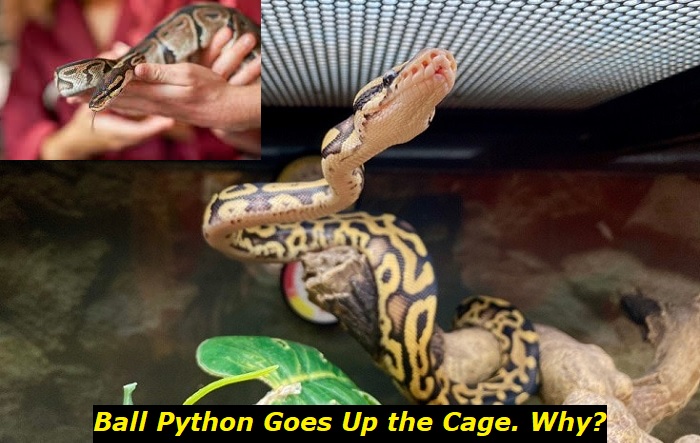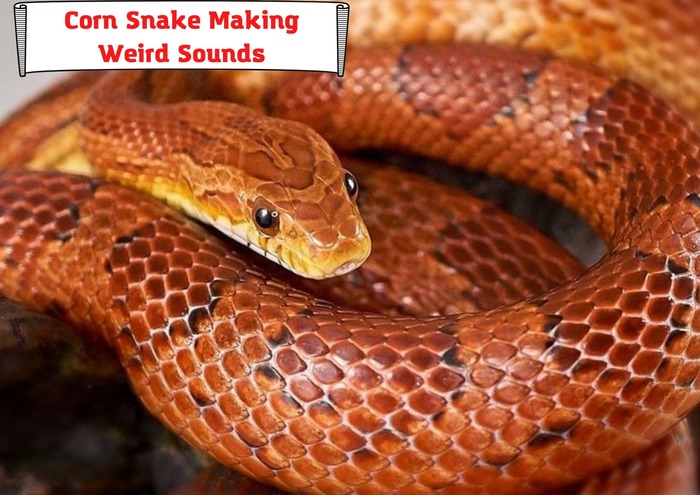Ball pythons love to explore their environment. The trick is figuring out when the activity is normal and when you should be worried. Suppose your ball python keeps climbing to the top of its cage. In that case, there is likely no reason to be alarmed, especially if any other worrisome symptoms do not accompany the repetitive climbing.
A ball python that seems healthy except for the repetitive climbing is likely undertaking a normal exploration of its environment. However, there is a slim possibility all is not as it should be. This article will help you figure out if something is actively driving your ball python away from the floor of its enclosure.

We will discuss several issues, including:
- Possible reasons your ball python keeps climbing to the top of the cage
- How to care for your ball python
- Common conditions that afflict ball pythons
Possible Reasons Your Ball Python Repetitively Climbs to the Top of the Cage
We have already mentioned that it is normal for ball pythons to climb to the top of their cages. However, if the behavior is unusually repetitive or it seems like your ball python is actively avoiding being on the floor of the cage, you are right to be concerned.
These are the most likely reasons your ball python keeps climbing to the top of its cage.
- Incorrect temperature range – you likely know your ball python is cold-blooded. Unlike you (and other warm-blooded creatures), your ball python depends entirely on external temperature conditions to regulate its body heat. If you fail to maintain the correct temperature range for your ball python, it has no choice but to seek optimal conditions. It may climb to the top of its cage to find a cooler or warmer spot.
- Incorrect humidity conditions may also cause your ball python to climb to the top of the cage in search of less or more humidity. You must maintain the recommended humidity range to keep your ball python healthy.
- Stressful conditions may also cause your ball python to escape to the top of its cage for safety. Loud noises, strong vibrations, excessive handling, inappropriate handling, injury, or illness could cause stress. Other common stressors are the cage’s lack of proper structural and environmental conditions. The cage should provide proper climbing and hiding spots. It should be maintained at optimal temperature, lighting, and humidity.
- Boredom could be driving your ball python up the wall. These intelligent reptiles require sufficient mental stimulation to remain happy and healthy for their natural lifespan. Your ball python’s cage should be large enough for free movement and enriched with structures that simulate its natural environment in the wild as much as possible.
- Your ball python is naturally reclusive and shy and gets pretty uncomfortable without a safe space to retreat to. Failure to have a hiding place could cause your ball python to climb to the top of its cage.
- An injured or ill ball python could climb to the top of its cage more frequently if this helps to ease or hide the symptoms it is experiencing.
Your ball python could be climbing to the top of its enclosure for any of these reasons. The best way to figure out the real cause Is by observing your ball python closely for any other signs of injury or illness. The earliest warning signs that something is wrong with your ball python include lethargy, loss of appetite, and unusual markings. At the end of the day, only a qualified reptilian veterinarian can diagnose and treat your ball python.
How to Care for Your Ball Python
Prevention is better than cure. Maintaining excellent conditions for your ball python is the best way to avoid any strange symptoms and illnesses. Lucky for you, ball pythons are relatively easy to care for. The tips below will help you take excellent care of your ball python.
- Cage size– Ball pythons are relatively small snakes but still need space to move around. It is recommended to house your ball python Hatchling in a 10-gallon and closure first long as it is less than 300 g. 40-gallon and closures are recommended for ball pythons heavier than 300 g but shorter than 3 inches. When your ball python grows past 3 inches long, please keep it in a 120-gallon tank or bigger. Treat your ball python to the biggest tank you can afford because it will keep it happy and healthy for as long as possible.
- Cage setup – After purchasing the perfect cage for your ball python, you must ensure that its setup is proper. Ball pythons only need a little to get by. Set up the cage in a location that is not exposed To the weather elements, e.g., sunlight. The cage should also have a secure lead that allows for ventilation while preventing your ball python from escaping. We have already mentioned how important hiding spots are for your shy ball python. If you want to go all out, have two hiding spots in the warm and cool regions of the cage. Your ball python will be happy to have a summer and winter hideout.
- Temperature – your ball python will not do well under fixed temperature conditions. It will require a temperature gradient that maintains one section of the cage at a lower temperature than the other. You aim to provide a basking spot around 90 degrees Fahrenheit and a cool spot around 78 degrees Fahrenheit. Heat lamps and under-tank heating pads come in handy to maintain the basking spot at optimal temperatures. You can use a thermostat to monitor and regulate the temperature as required.
- Lighting – your boy does not require the light; however, if you want to go the extra mile, you can use UVB lighting to create a fixed day and night schedule that will regulate your python’s behavior
- Humidity – purchase Hygrometer and use it to ensure that the humidity level in your ball python enclosure is at 50%. The enclosure should also have a water dish for your ball python to take a luxurious over the mood strikes.
- Diet – Your carnivorous ball python should have a diet of appropriately sized rodents. Please do not feed your snake any wild caught or live prey because it is dangerous. Young ball pythons should be fed every five days. Adults should eat after seven to ten days.
- Handling – though ball pythons can be safely handled, it is best to do it as least as possible. When you handle your python, approach it calmly and gently. For the first week after bringing your ball python, do not handle it. It is best to allow the snake to adjust to its new environment. After the first week, remember that ball pythons are easily stressed. This means that you should avoid handling them after feeding or during shedding.
- Health – keeping a close eye on Your ball python is a key part of being a responsible pet owner. You must monitor sudden changes in your pet’s appetite, behavior, or appearance. Any unusual changes should be brought to the attention of a reptile veterinarian as soon as possible.
Common Illnesses Affecting Ball Pythons
Our quest to ensure your ball python has a happy and healthy life will end once we mention some illnesses it could suffer from.
- Internal and external parasites may leach onto your ball python for various reasons. The most common are failure to clean the enclosure properly and feeding the python prey animals that are infected. If your ball python is under attack by parasites like six months round ones or tables common, the most common signs will be poor appetite, weight loss, lethargy, and unusual shedding.
- Respiratory infections often ball pythons. Should your ball python begin to suffer lethargy, open-mouthed breathing, wheezing, and produce discharge from the mouth or nose, you must consult a reptile Veterinarian soon as possible.
- Mouth rot – this bacterial infection affects your ball python’s mouth and gums. It is often caused by failure to maintain hygienic conditions. Symptoms of mouth rot include inflammation of the mouth and the production of a peculiar discharge. These symptoms will be accompanied by lethargy and loss of appetite.
- Scale rot – another bacterial infection that afflicts the skin and scales of your ball python. Poor hygiene standards, injury to the skin, or inadequate humidity usually cause it. If your ball python is suffering scale rot, you will likely notice lethargic behavior, discoloration, and inflammation of the skin.
- Neurological conditions in ball pythons present through head tilts or seizures. Genetics, infections, and nutritional deficiencies typically cause these conditions.
Conclusion
Do not hesitate to book an appointment with a reptile veterinarian whenever you notice any of the above-mentioned symptoms. If the only issue is that your ball python keeps climbing to the top of its cage, chances are high it is right as rain.
If you’d rather not take your chances, consulting a veterinarian is always a good idea and one you will never regret. The sooner you take your ball python to the vet, The better chance you have at preventing serious health conditions from developing.
- Pacman Frog Looks Deflated – What’s Wrong and What to Do? - August 7, 2023
- How to Put Snake Back in Cage after Feeding? Important Concerns - July 31, 2023
- Repta Boost: Instruction, Considerations, Ways to Use - July 24, 2023



